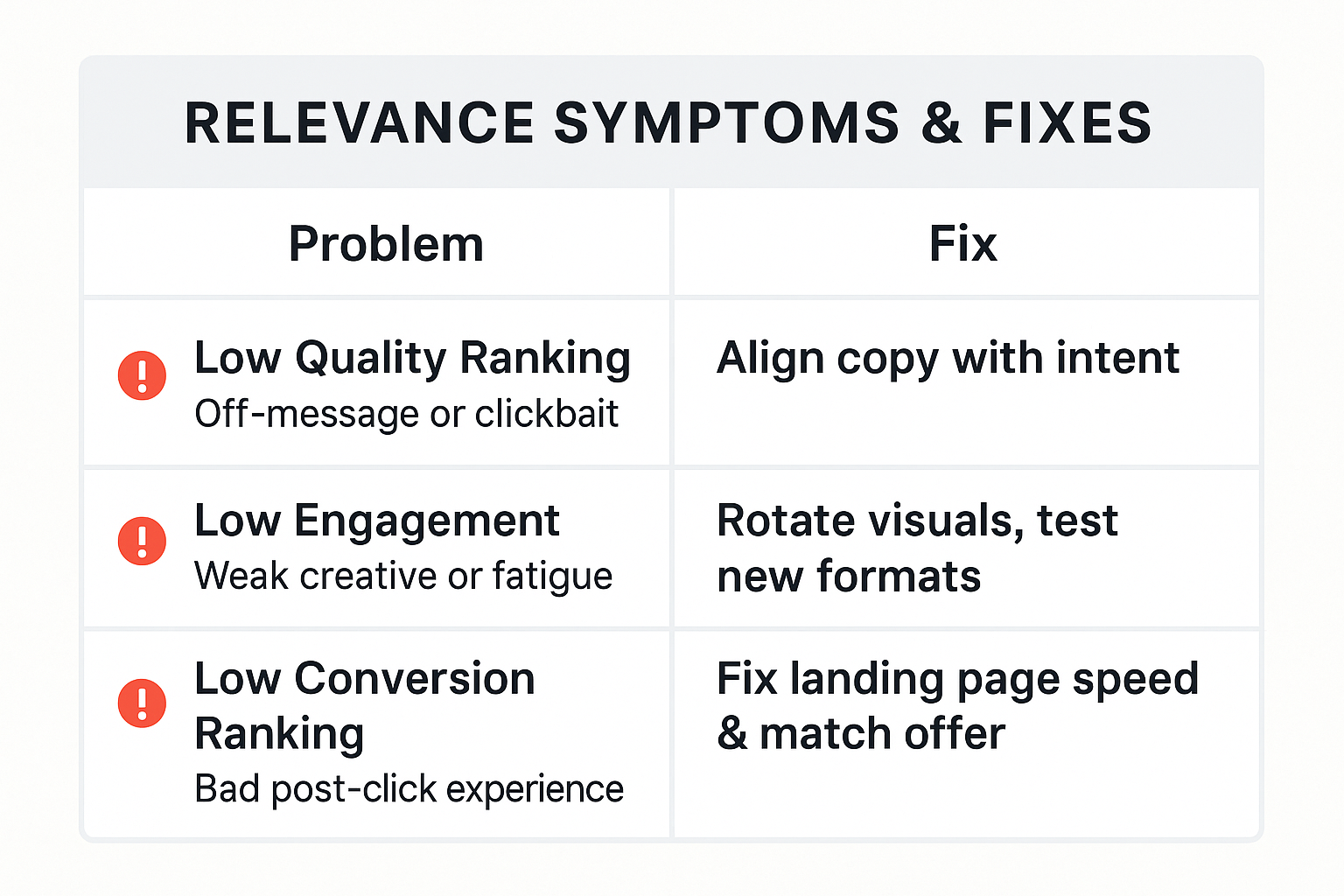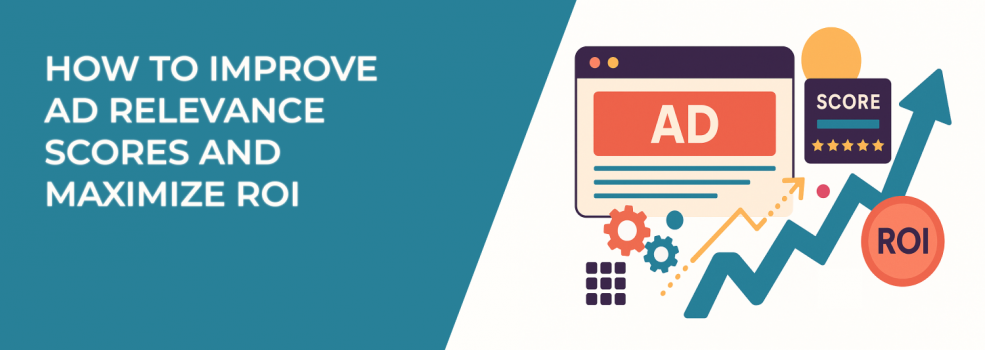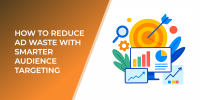If your Facebook or Meta ads are struggling to gain traction — or if your cost-per-click keeps creeping up — it might not be your product, offer, or even your budget.
More often than not, the problem is your ad relevance score.
This underrated metric plays a huge role in whether your ads perform or disappear. Understanding it (and knowing how to improve it) can mean the difference between profitable scaling and wasted spend.
What Is Ad Relevance Score — and Why It Impacts ROI
Ad relevance score is Meta’s way of telling you whether your ad actually matters to your target audience. It’s a quality ranking — based on user behavior, engagement signals, post-click actions, and overall fit with the audience you're targeting.

A high relevance score means your ad is aligned with user interest. When that happens, the algorithm rewards you with better placement and lower costs.
A low score? You pay more, reach fewer people, and eventually get pushed out of the auction.
Put simply: your relevance score affects both performance and ROI. It’s a multiplier — good or bad.
Want to stop overpaying for underperforming ads? Here’s what to focus on.
1. Fix Targeting First — Or Nothing Else Will Work
Most relevance issues start with poor targeting. If your ads are shown to the wrong people, no amount of great creative can fix the mismatch.
Here's what to check:
-
Audience segmentation: Are you clearly separating cold, warm, and hot audiences? Blending them into a single ad set leads to confusing performance data and lower relevance.
-
Exclusions: Are you excluding converters from your prospecting ad sets? If not, you’re wasting budget on people who’ve already taken action.
-
Cold vs. retargeting: Cold audiences should be built using lookalikes, interest stacks, or behavior-based signals. Warm audiences should be built from people who already engaged, clicked, or visited your site.
If you're unsure how to structure your segments, this guide to Facebook ad targeting offers a solid starting point.
2. Align Message and Audience — Relevance Lives or Dies Here
Even if your audience targeting is technically correct, it won’t matter if your message doesn’t resonate.
Think of it this way: if your ad talks about pricing but the user hasn’t even decided whether they need the product, they’ll skip it. Fast. That tanks your engagement — and your relevance score along with it.

Here’s how to sharpen the match:
-
Cold audiences need awareness content. Lead with value, not discounts. Solve a problem, answer a question, or introduce something new.
-
Warm audiences (site visitors, social engagers) want proof, incentives, and comparisons. This is where you can test offers, urgency, and product-specific messaging.
-
Hot audiences (cart abandoners, lead form starters) often just need a reminder or a nudge. Reinforce trust. Use testimonials, guarantees, or friction removers.
Each layer of your funnel deserves its own tailored creative. Copy-pasting the same ad across all audiences is one of the easiest ways to destroy your score.
If you’re not sure how to craft audience-driven messaging, check out this deep dive on maximizing ROI through segmentation.
3. Improve Your Creative Quality — The First Scroll-Stopper Wins
Your creative is the first filter users see. And the algorithm doesn’t just judge your content based on clicks — it tracks watch time, post reactions, hides, and negative feedback.
The more engaging your ad, the more it gets shown — and the cheaper each result becomes.
Ways to level up your creative:
-
Use native-feeling formats: Ads that blend into the feed often outperform polished, overproduced content. Especially on mobile.
-
Incorporate motion: Even a short animated GIF or simple movement in a static image can help your ad stand out.
-
Test visuals relentlessly: Headlines and CTAs matter, but your visual gets seen first. Use multiple images and videos, and rotate them frequently to avoid fatigue.
If you're stuck with underwhelming creative, here's how to spot and fix ad fatigue fast.
And for high-volume creative testing, these AI-powered tools can help you scale content without starting from scratch.
4. Make Your Copy Easy to Read — and Hard to Ignore
You’ve only got a few seconds to stop the scroll. And when your copy is dense, vague, or looks like every other ad — people swipe past.
Here's how to write ads people actually want to read:
-
Start with a bold hook: Ask a question. Expose a pain point. Make a claim that demands attention.
-
Break it up: Use short paragraphs, line breaks, and bullets. Dense walls of text kill attention.
-
Speak like your audience: Avoid generic marketing phrases. Use the tone and vocabulary your audience actually uses.
Your goal isn’t to win awards. Your goal is to get read, build connection, and earn the click.
For a complete copy audit, this article on how to structure high-converting Facebook ads is a must-read.
5. Fix the Post-Click Experience — Or the Algorithm Will Penalize You
Your relevance score isn’t just based on what happens in the feed. Meta tracks how users behave after clicking your ad. If they bounce quickly, close the tab, or fail to engage, your score drops.
Here’s how to tighten that up:
-
Match the landing page to the ad: Don’t bait-and-switch. Your visual, headline, and offer should be reflected immediately after the click.
-
Speed matters: Slow mobile pages will tank your performance. Aim for under 3 seconds of load time.
-
Eliminate friction: Limit your forms to what’s absolutely necessary. Make the CTA button stand out. Reduce distractions and dead ends.
Need help fixing funnel leaks? Learn how to optimize for post-click performance to protect both conversions and your relevance metrics.
6. Monitor Relevance Signals Closely and React Fast
Meta no longer gives you a single "relevance score" like it used to. Instead, you get three metrics:
-
Quality Ranking,
-
Engagement Rate Ranking,
-
Conversion Rate Ranking.
Each is graded as Above Average, Average, or Below Average. Use these to diagnose what’s working — and what’s not.
If you see low Quality but decent Engagement, your copy may be off-message. If Engagement is poor, your creative likely needs a refresh. If Conversion is low, your funnel is probably broken.
For more nuance, here's how to interpret Facebook's quality and engagement metrics.
Final Takeaway: Relevance Is the Shortcut to Better ROI
Improving your ad relevance score isn’t just about making Meta happy — it’s about making your spend work harder. Better targeting, tighter messaging, and smarter creative all signal to the algorithm: this ad deserves to be seen.
Want more visibility for less money? Want more ROI without doubling your budget?
Start by fixing relevance. The return is faster than you think.

